Aryl Itaconic Acids from Aryl Aldehydes and (Triphenylphosphoranylidene)succinic Anhydride via a One-Pot Ring-Opening–Wittig Olefination–Hydrolysis Reaction †
Abstract
1. Introduction
2. Materials and Methods
2.1. General—Chemical Preparation
2.2. Experimental—Chemical Synthesis
2.3. Antibacterial Assay—Methodology
2.4. Antibacterial Assay—Experimental
3. Results and Discussion
3.1. Wittig Olefination Preparation of Aryl Itaconic Acids
3.2. Antibacterial Activity of the Synthesized Compounds
3.3. Minimum Inhibitory Concentration (MIC) Assay of Compounds Against Gram Positive and Gram-Negative Bacteria
4. Conclusions
Author Contributions
Funding
Institutional Review Board Statement
Informed Consent Statement
Data Availability Statement
Acknowledgments
Conflicts of Interest
References
- Zhao, H.; Teng, D.; Yang, L.; Xu, X.; Chen, J.; Jiang, T.; Feng, A.Y.; Zhang, Y.; Frederick, D.T.; Gu, L.; et al. Myeloid-derived itaconate suppresses cytotoxic CD8+ T cells and promotes tumour growth. Nature Metabol. 2022, 4, 1660–1673. [Google Scholar] [CrossRef]
- Migaud, M.E.; Chee-Sanford, J.-C.; Tiedje, J.M.; Frost, J.W. Benzylfumaric, benzylmaleic, and Z- and E-phenylitaconic acids: Synthesis, characterization, and correlation with a metabolite generated by Azoarcus tolulyticus Tol-4 during anaerobic toluene degradation. Appl. Environ. Microbiol. 1996, 62, 974–978. [Google Scholar] [CrossRef] [PubMed]
- Lao, A.; Fujimoto, Y.; Tatsuno, T. Studies on the constituents of Artemisia argyi Levl and Vant. Chem. Pharm. Bull. 1984, 32, 723–727. [Google Scholar] [CrossRef]
- Rao, K.R.; Bagavant, G. Stobbe condensation. Formation of fulgenic and itaconic acids. Indian J. Chem. 1969, 7, 859–861. [Google Scholar]
- Wang, Y.; Zhong, Z.; Wu, G.; Chang, Y. Design, synthesis and hypoglycemic activity of α-benzylsuccinic acid derivatives. Yaoxue Xuebao 2009, 44, 491–495. [Google Scholar]
- Bankole, A.A.; Poulose, V.; Ramachandran, T.; Hamed, F.; Thiemann, T. Comparative study of the selective sorption of organic dyes on inorganic materials—A cost-effective method for waste treatment in educational and small research laboratories. Separations 2022, 9, 144. [Google Scholar] [CrossRef]
- Johnstone, R.A.W.; Rose, M.E. A rapid, simple, and mild procedure for alkylation of phenols, alcohols, amides and acids. Tetrahedron 1979, 35, 2169–2173. [Google Scholar] [CrossRef]
- Hudson, R.F.; Chopard, P.A. Structure et reactions du compose d’addition: Triphenylphosphine—Anhydride maléique. Helv. Chim. Acta 1963, 46, 2178–2185. [Google Scholar] [CrossRef]
- Kulkarni, A.B.; Pandit, A.L.; Shroff, H.D.; Hosangadi, B.D.; Katrak, M.N.; Diwadkar, A.B.; Ginde, B.S. Conformational analysis. I. Stereochemistry of itaconic acids. Indian J. Chem. 1964, 2, 443–448. [Google Scholar]
- Adair, G.R.A.; Edwards, M.G.; Williams, J.M.J. Triphenylphosphine-catalysed conversion of maleic anhydride into acrylate esters. Tetrahedron Lett. 2003, 44, 5523–5525. [Google Scholar] [CrossRef]
- Nowrouzi, N.; Abbasi, M.; Zellifard, Z. Ph3P-mediated decarboxylative ring-opening of maleic anhydride by thiolic compounds: Formation of two carbon–sulfur bonds. RSC Adv. 2023, 13, 9242–9246. [Google Scholar] [CrossRef] [PubMed]
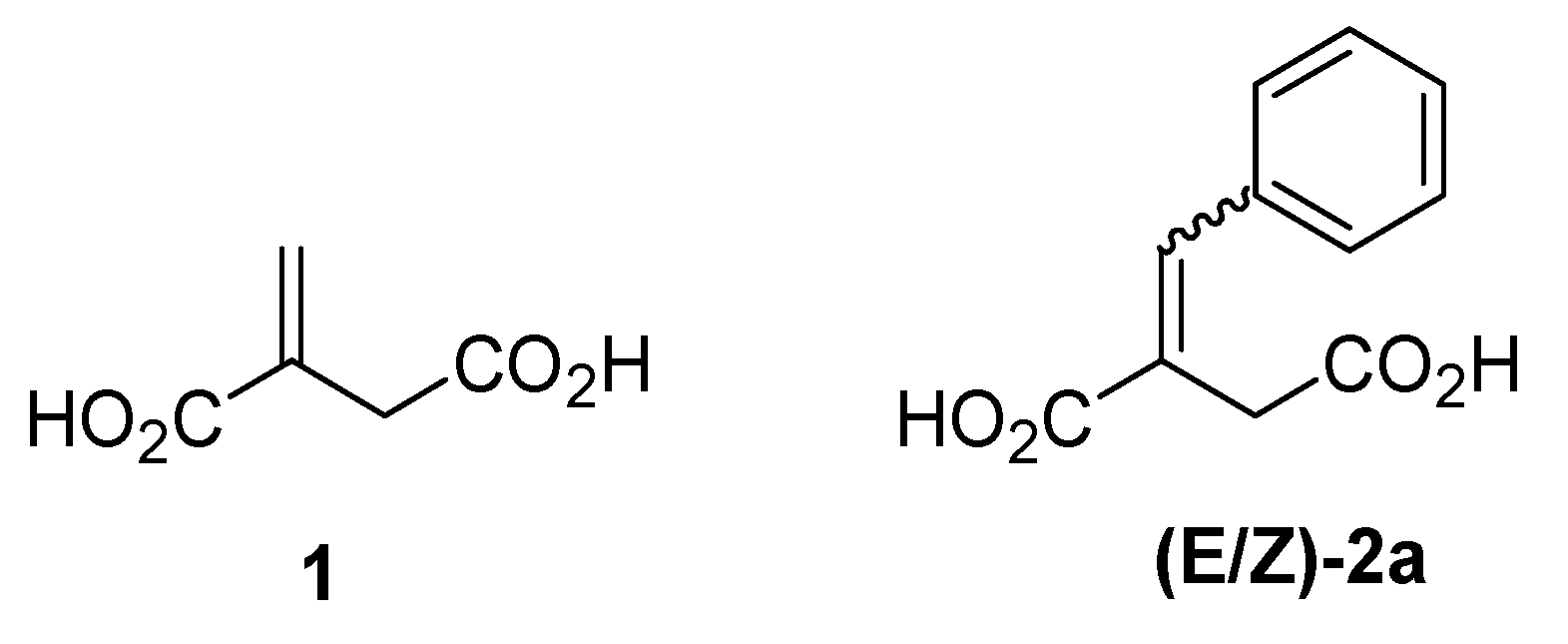

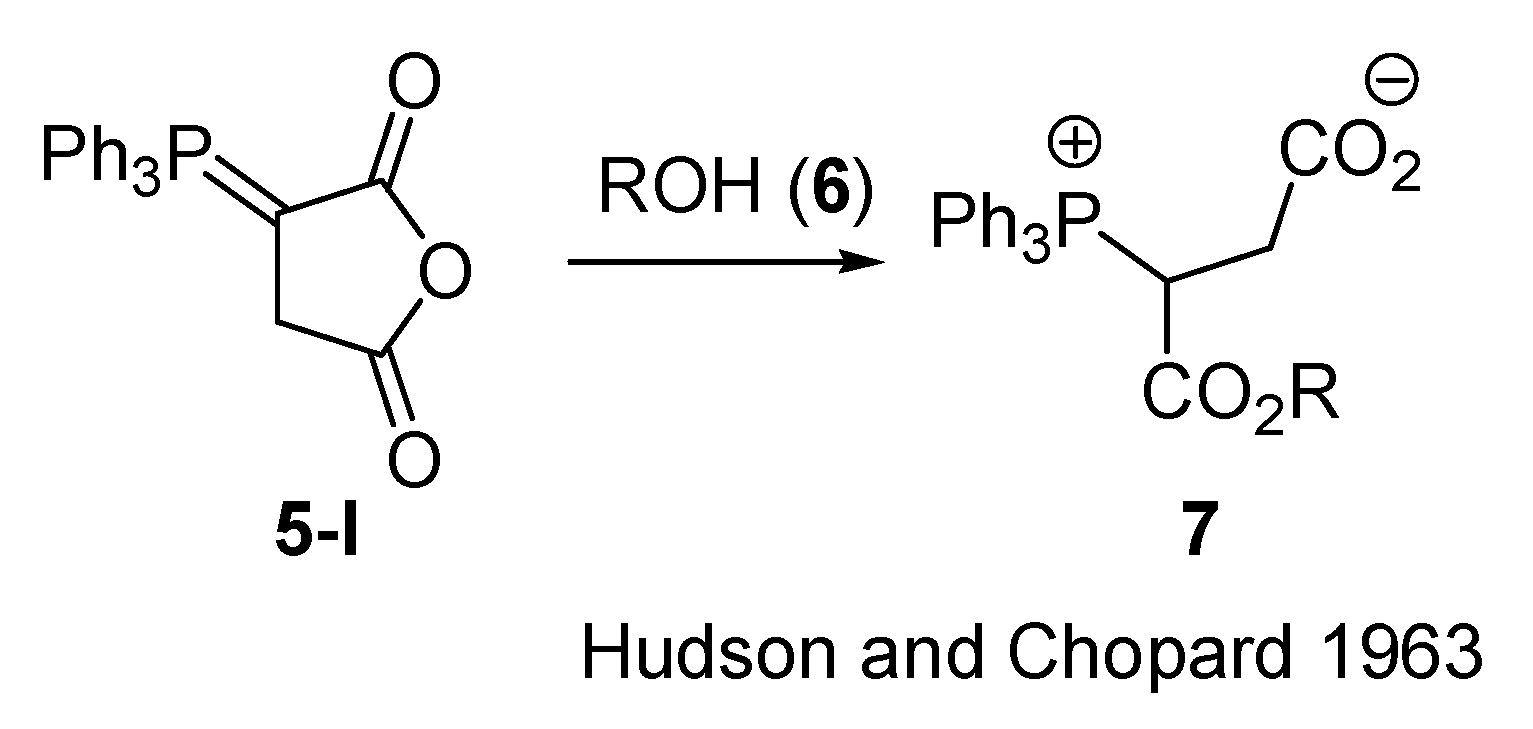

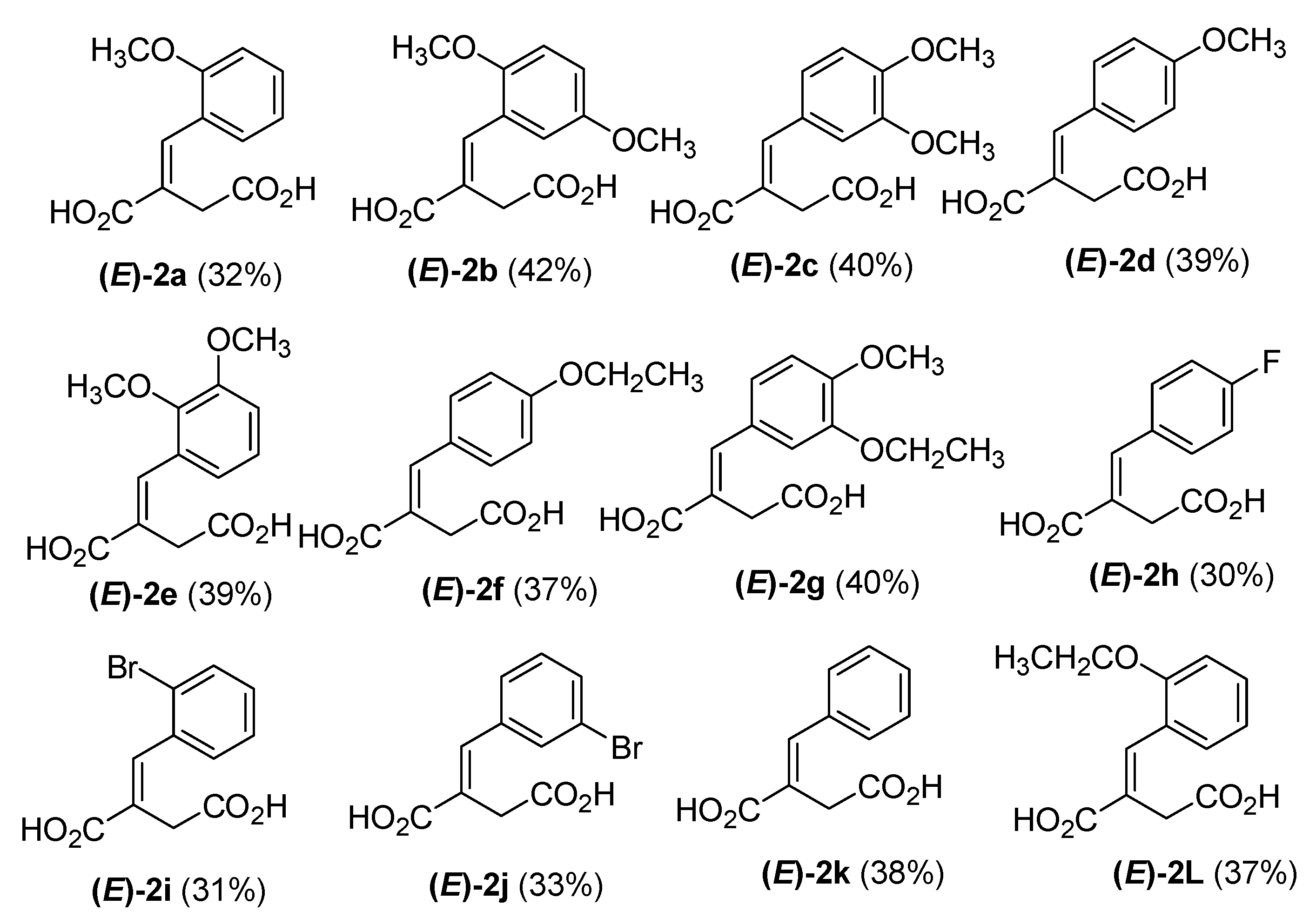
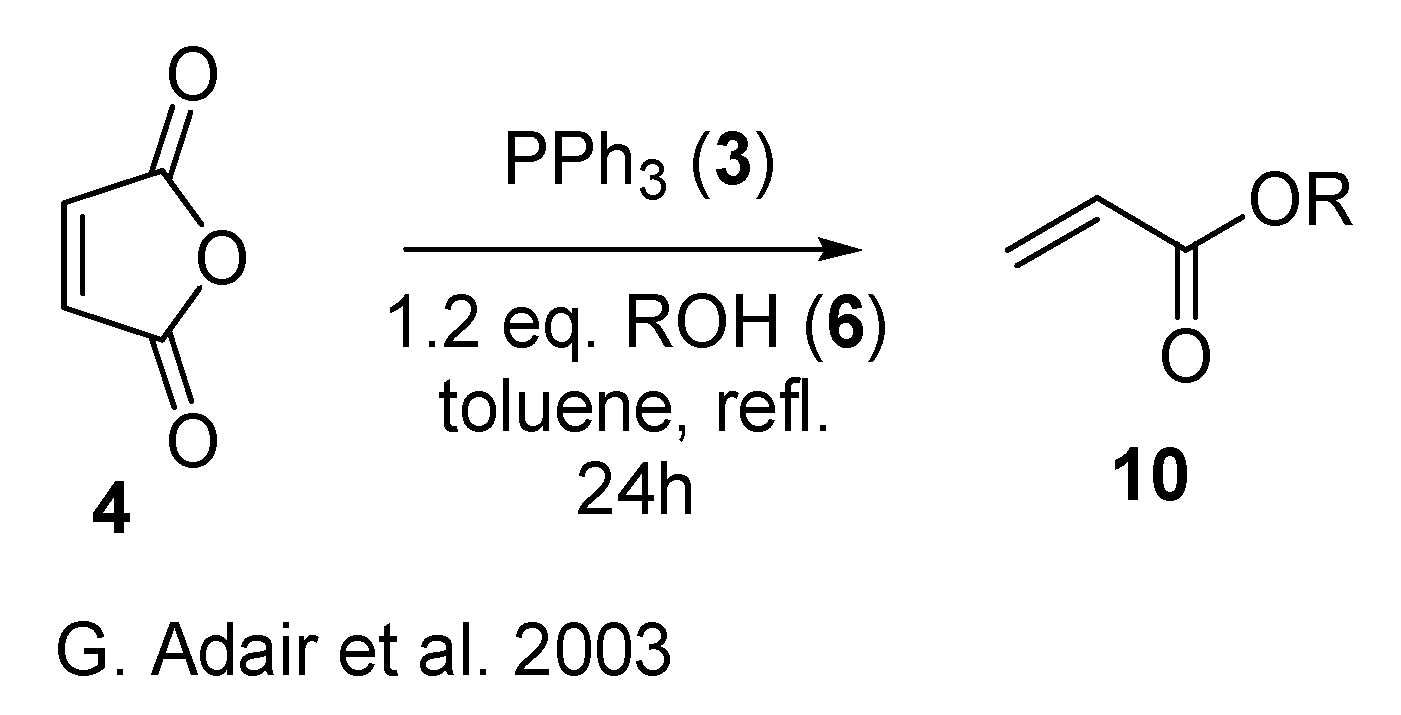
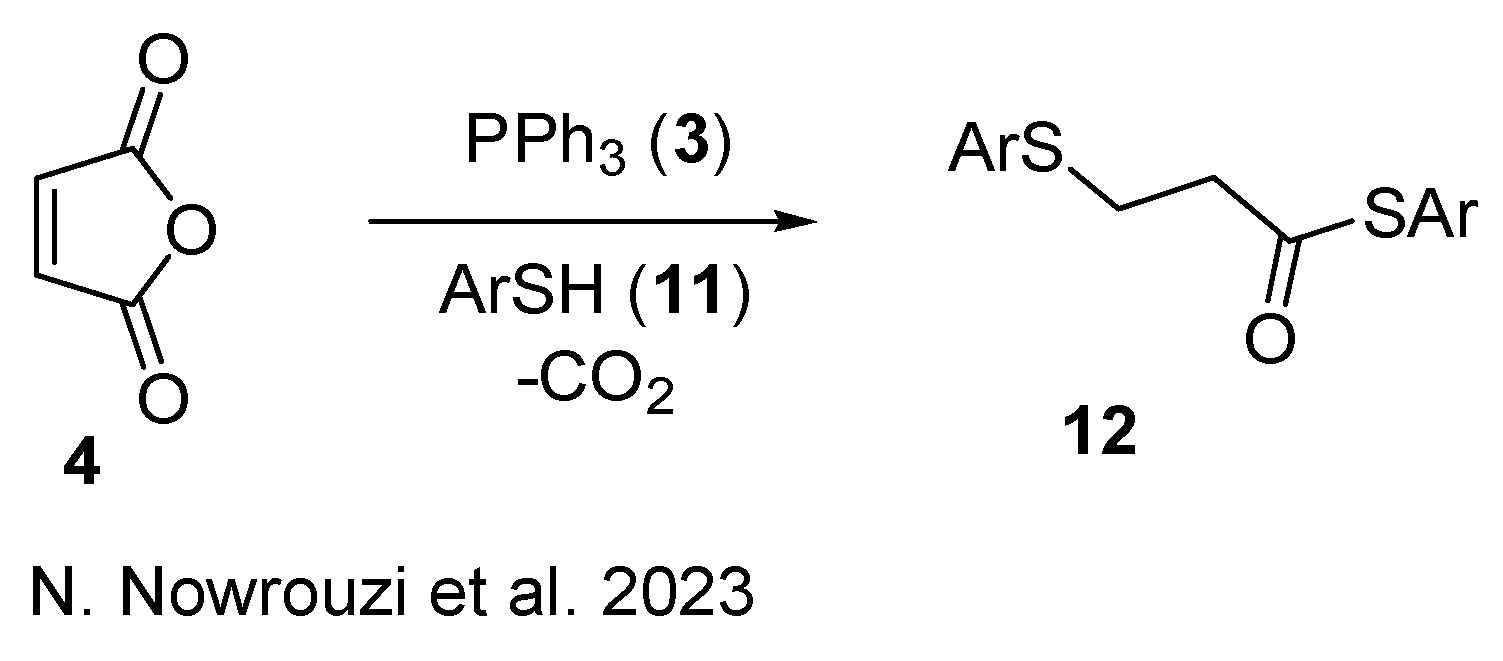
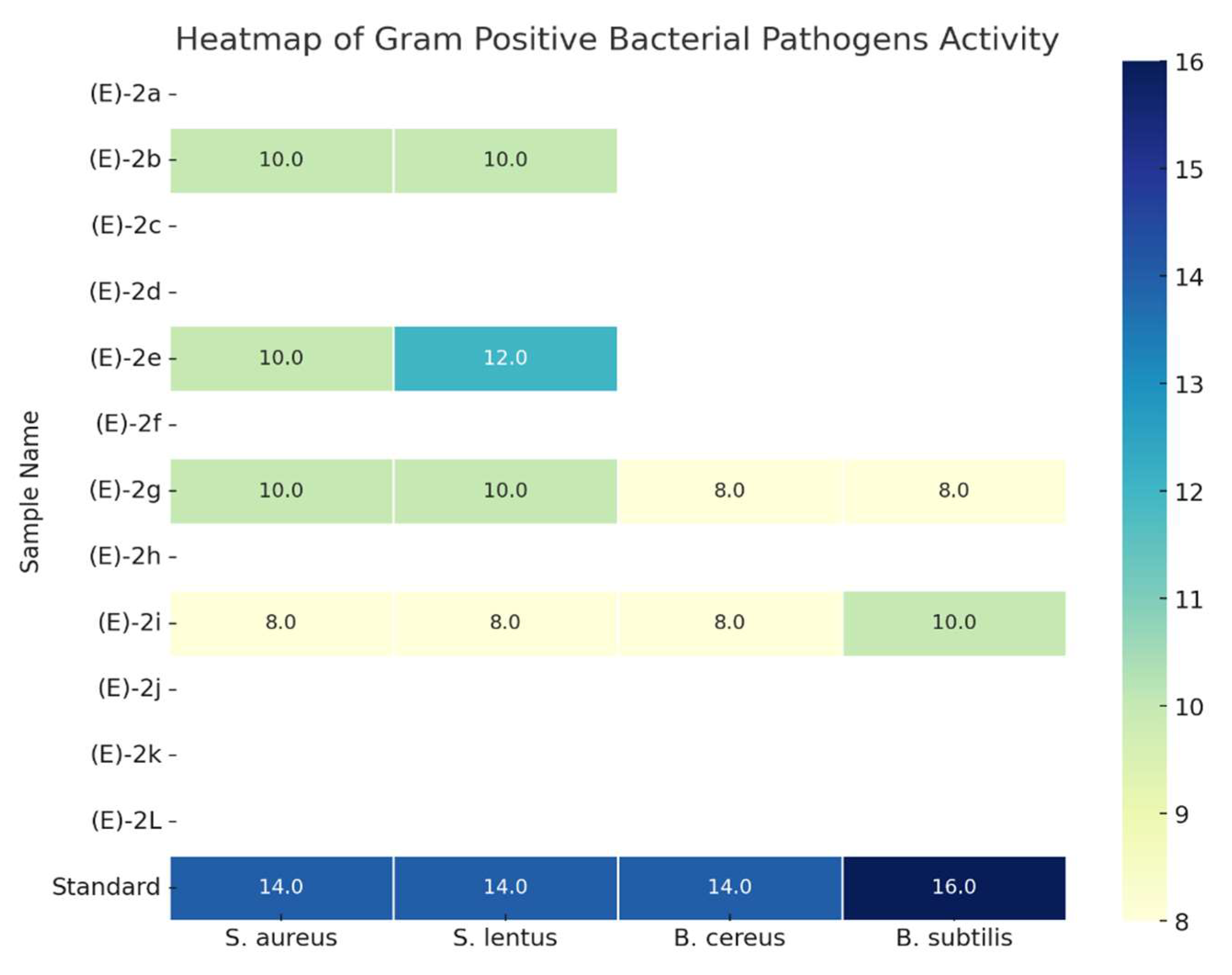


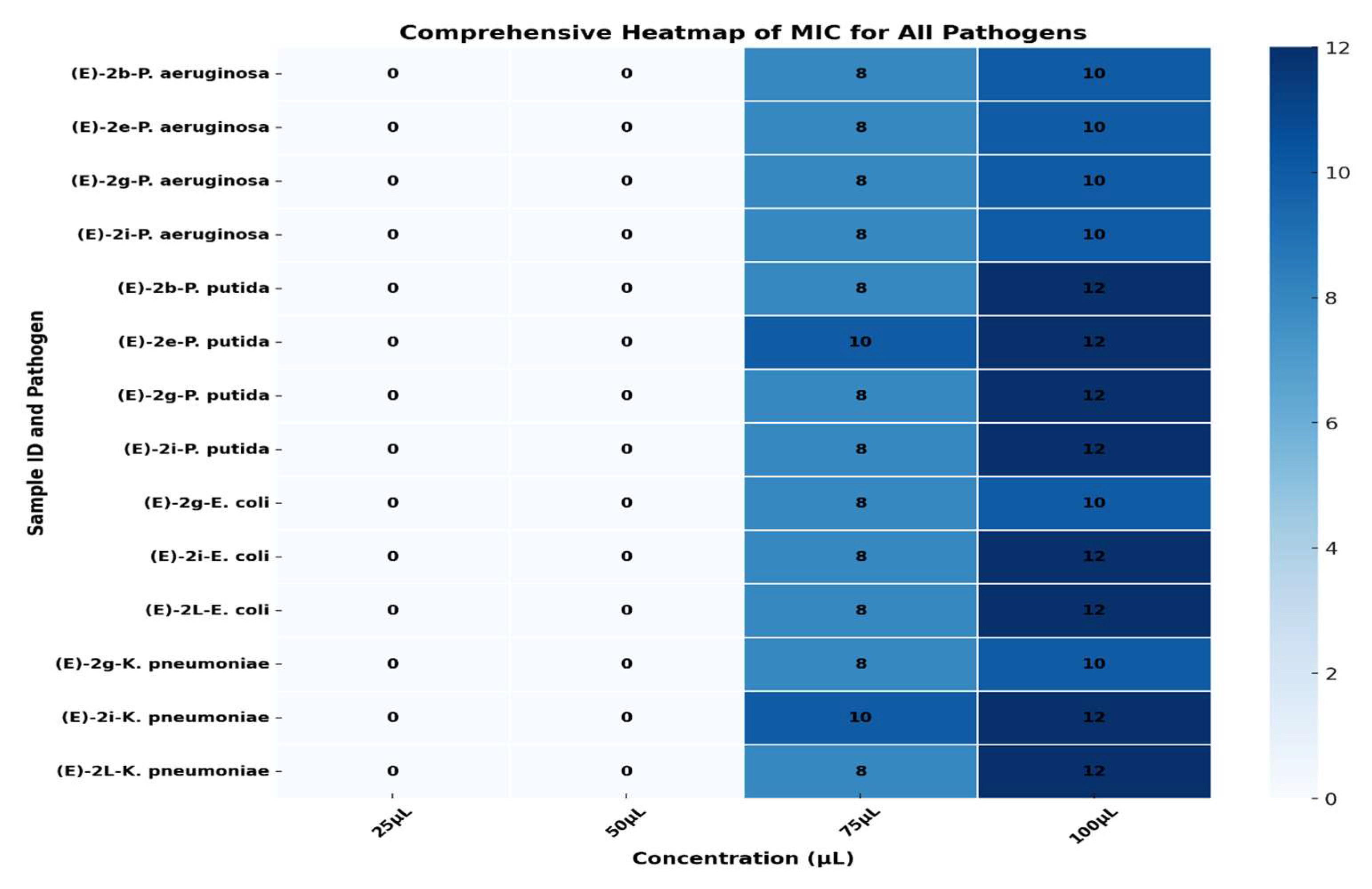
| Scheme | Sample Name | Gram Positive Bacterial Pathogens | |||
|---|---|---|---|---|---|
| S. aureus | S. lentus | B. cereus | B. subtilis | ||
| 1 | (E)-2a | No activity | No activity | No activity | No activity |
| 2 | (E)-2b | 10 mm | 10 mm | No activity | No activity |
| 3 | (E)-2c | No activity | No activity | No activity | No activity |
| 4 | (E)-2d | No activity | No activity | No activity | No activity |
| 5 | (E)-2e | 10 mm | 12 mm | No activity | No activity |
| 6 | (E)-2f | No activity | No activity | No activity | No activity |
| 7 | (E)-2g | 10 mm | 10 mm | 08 mm | 08 mm |
| 8 | (E)-2h | No activity | No activity | No activity | No activity |
| 9 | (E)-2i | 08 mm | 08 mm | 08 mm | 10 mm |
| 10 | (E)-2j | No activity | No activity | No activity | No activity |
| 11 | (E)-2k | No activity | No activity | No activity | No activity |
| 12 | (E)-2L | No activity | No activity | No activity | No activity |
| 13 | Standard | 14 mm | 14 mm | 14 mm | 16 mm |
| S.no | Sample Name | Gram Negative Bacterial Pathogens | |||
|---|---|---|---|---|---|
| P. aeruginosa | P. putida | E. coli | K. pneumoniae | ||
| 1 | (E)-2a | No activity | No activity | No activity | No activity |
| 2 | (E)-2b | 12 mm | 10 mm | No activity | No activity |
| 3 | (E)-2c | No activity | No activity | No activity | No activity |
| 4 | (E)-2d | No activity | No activity | No activity | No activity |
| 5 | (E)-2e | 12 mm | 14 mm | No activity | No activity |
| 6 | (E)-2f | No activity | No activity | No activity | No activity |
| 7 | (E)-2g | 10 mm | 10 mm | 08 mm | 10 mm |
| 8 | (E)-2h | No activity | No activity | No activity | No activity |
| 9 | (E)-2i | 10 mm | 12 mm | 10 mm | 10 mm |
| 10 | (E)-2j | No activity | No activity | No activity | No activity |
| 11 | (E)-2k | No activity | No activity | No activity | No activity |
| 12 | (E)-2L | No activity | No activity | 10 mm | 10 mm |
| 13 | Standard | 14 mm | 14 mm | 14 mm | 16 mm |
| S.no | Sample ID | MINIMUM INHIBITORY CONCENTRATION—MIC (mm) | MIC of Sample (µL) | |||
|---|---|---|---|---|---|---|
| S. aureus | ||||||
| 25 µL | 50 µL | 75 µL | 100 µL | |||
| 1 | (E)-2b | - | - | 08 mm | 10 mm | 75 µL |
| 2 | (E)-2e | - | - | 12 mm | 14 mm | 75 µL |
| 3 | (E)-2g | - | - | 10 mm | 14 mm | 75 µL |
| 4 | (E)-2i | - | - | 08 mm | 10 mm | 75 µL |
| S. lentus | ||||||
| 1 | (E)-2b | - | 08 mm | 10 mm | 12 mm | 50 µL |
| 2 | (E)-2e | - | - | 08 mm | 12 mm | 75 µL |
| 3 | (E)-2g | - | - | 08 mm | 12 mm | 75 µL |
| 4 | (E)-2i | - | 08 mm | 10 mm | 12 mm | 50 µL |
| B. cereus | ||||||
| 1 | (E)-2g | - | - | - | 10 mm | 100 µL |
| 2 | (E)-2i | - | - | - | 10 mm | 100 µL |
| B. subtilis | ||||||
| 1 | (E)-2g | - | - | - | 10 mm | 100 µL |
| 2 | (E)-2i | - | - | - | 08 mm | 100 µL |
| S.no | Sample ID | MINIMUM INHIBITORY CONCENTRATION—MIC (mm) | MIC of Sample (µL) | |||
|---|---|---|---|---|---|---|
| P. aeruginosa | ||||||
| 25 µL | 50 µL | 75 µL | 100 µL | |||
| 1 | (E)-2b | - | - | 08 mm | 10 mm | 75 µL |
| 2 | (E)-2e | - | - | 08 mm | 10 mm | 75 µL |
| 3 | (E)-2g | - | - | 08 mm | 10 mm | 75 µL |
| 4 | (E)-2i | - | - | 08 mm | 10 mm | 75 µL |
| P. putida | ||||||
| 1 | (E)-2b | - | - | 08 mm | 12 mm | 75 µL |
| 2 | (E)-2e | - | - | 10 mm | 12 mm | 75 µL |
| 3 | (E)-2g | - | - | 08 mm | 12 mm | 75 µL |
| 4 | (E)-2i | - | - | 08 mm | 12 mm | 75 µL |
| E. coli | ||||||
| 1 | (E)-2g | - | - | 08 mm | 10 mm | 75 µL |
| 2 | (E)-2i | - | - | 08 mm | 12 mm | 75 µL |
| 3 | (E)-2L | - | - | 08 mm | 12 mm | 75 µL |
| K. pneumoniae | ||||||
| 1 | (E)-2g | - | - | 08 mm | 10 mm | 75 µL |
| 2 | (E)-2i | - | - | 10 mm | 12 mm | 75 µL |
| 3 | (E)-2L | - | - | 08 mm | 12 mm | 75 µL |
Disclaimer/Publisher’s Note: The statements, opinions and data contained in all publications are solely those of the individual author(s) and contributor(s) and not of MDPI and/or the editor(s). MDPI and/or the editor(s) disclaim responsibility for any injury to people or property resulting from any ideas, methods, instructions or products referred to in the content. |
© 2024 by the authors. Licensee MDPI, Basel, Switzerland. This article is an open access article distributed under the terms and conditions of the Creative Commons Attribution (CC BY) license (https://creativecommons.org/licenses/by/4.0/).
Share and Cite
Poulose, V.; Almheiri, S.; Alwahedi, N.; Alzeyoudi, A.; Aghaei, M.; Gopi, S.; Thiemann, T. Aryl Itaconic Acids from Aryl Aldehydes and (Triphenylphosphoranylidene)succinic Anhydride via a One-Pot Ring-Opening–Wittig Olefination–Hydrolysis Reaction. Chem. Proc. 2024, 16, 37. https://doi.org/10.3390/ecsoc-28-20117
Poulose V, Almheiri S, Alwahedi N, Alzeyoudi A, Aghaei M, Gopi S, Thiemann T. Aryl Itaconic Acids from Aryl Aldehydes and (Triphenylphosphoranylidene)succinic Anhydride via a One-Pot Ring-Opening–Wittig Olefination–Hydrolysis Reaction. Chemistry Proceedings. 2024; 16(1):37. https://doi.org/10.3390/ecsoc-28-20117
Chicago/Turabian StylePoulose, Vijo, Salama Almheiri, Noura Alwahedi, Arwa Alzeyoudi, Maryam Aghaei, Sreeraj Gopi, and Thies Thiemann. 2024. "Aryl Itaconic Acids from Aryl Aldehydes and (Triphenylphosphoranylidene)succinic Anhydride via a One-Pot Ring-Opening–Wittig Olefination–Hydrolysis Reaction" Chemistry Proceedings 16, no. 1: 37. https://doi.org/10.3390/ecsoc-28-20117
APA StylePoulose, V., Almheiri, S., Alwahedi, N., Alzeyoudi, A., Aghaei, M., Gopi, S., & Thiemann, T. (2024). Aryl Itaconic Acids from Aryl Aldehydes and (Triphenylphosphoranylidene)succinic Anhydride via a One-Pot Ring-Opening–Wittig Olefination–Hydrolysis Reaction. Chemistry Proceedings, 16(1), 37. https://doi.org/10.3390/ecsoc-28-20117







